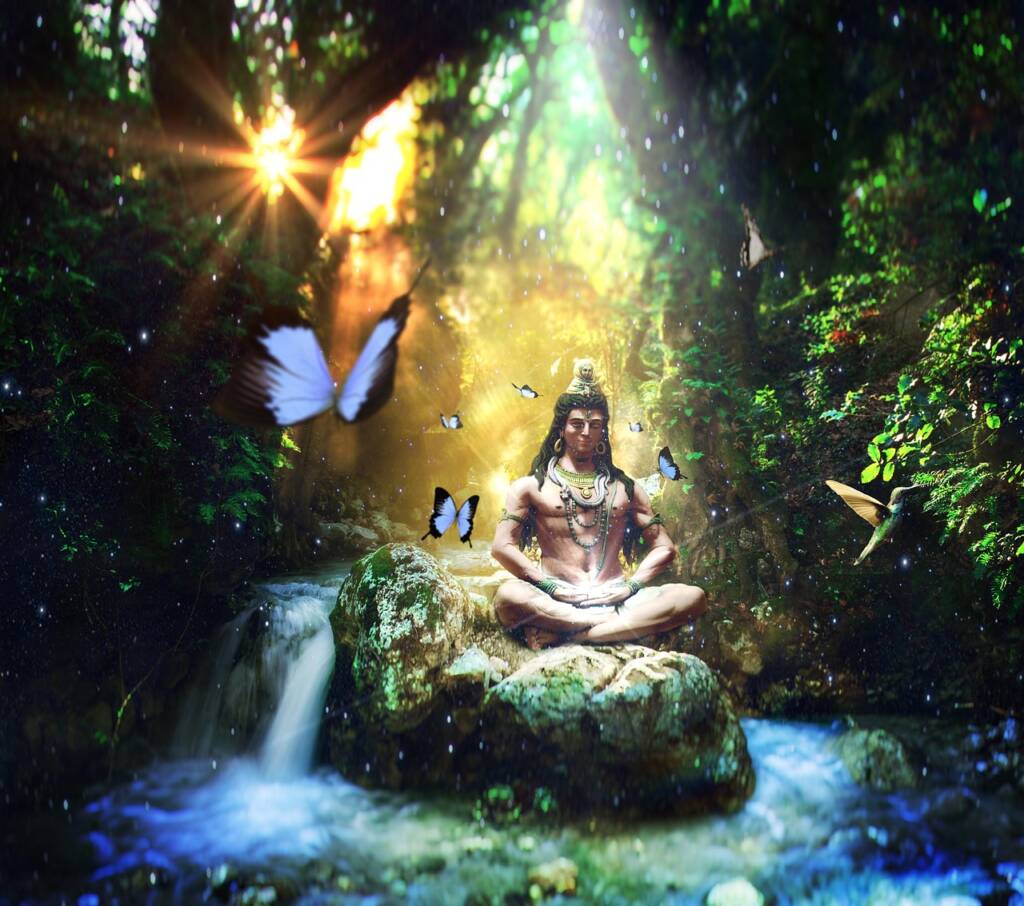In the previous article Kularnava Tantra part II we continued to analyze the famous tantric text, Kularnava Tantra, a major tantric text of the Kaula school, written in the form of a dialogue between Shiva and Parvati.
From chapter twelve until chapter seventeen, we will hear descriptions of the proper behavior in front of the guru as well as characteristics of righteous disciples. We will hear about japa as the highest form of worship, as well as the gifts that are obtained by merely hearing the Glory of Urdhvamayana.
Chapter Twelve
In the twelfth chapter, we hear descriptions of the correct conduct in front of the guru. Paduka represents honoring the feet of the guru, which symbolizes complete adoration and abnegation, the total giving of oneself. To cherish the sandals that hold the guru’s feet epitomizes the humble attitude.
On the Path of Kula, devotion to the guru excels even above yoga, tapas, and all ritual practices;
“Sri Devi said : O Kulesa ! I want to hear about the characteristics of devotion to Paduka and the Acaras connected with it. O Ocean of Compassion ! Kindly tell me about the same.
Devi! Remember this Paduka which yields infinitely greater merit than billions and billions of Mantra-Japa, billions and billions of pilgrimages, and billions and billions of worship. If remembered this Paduka provides protection against diseases, great disturbances, great evils, great fears, great calamities, and great sins. If remembered this Paduka provides protection against bad conduct, bad talks, bad company, bad accumulations, bad food, and bad thought. Hence the Paduka is to be remembered and known. One who remembers it on the tip of his tongue and worships this Paduka obtains all his desires.
One who worships this Paduka with devotion, he, getting released from all his sins, obtains the ultimate State.”
Chapter Thirteen
In the thirteenth chapter, the characteristics of Sisyas, or disciples, who should be rejected (by the guru) are described, as well as different kinds of Gurus and the characteristics of a superior Guru.
In the following quote, are described the characteristics of Sisyas who are acceptable to the Guru;
“O, Kulesani! The disciple chosen shall be one who is endowed with auspicious features; given to Sadhana that leads to Samadhi; of good qualities and culture; clean of body and apparel; wise; devoted to Dharma; pure of mind; steady in observances; of truthful practice; gifted with faith and devotion; diligent; sparsely eating; deep thoughted; serving without motive; scrutinizing; heroic; free from poverty of mind; skillful in all actions; clean; obliging to all; grateful; afraid of sin; approved of the holy and the good; believer in God; liberal; engaged in the good of all creatures. He shall be one who has trust and modesty; who is not given to deceive in matters of wealth, body, etc., achieves the impossible; is brave, enthusiastic, and strong; engaged in favorable activities; not intoxicated; able; helpful; truthful; limited and smiling in speech; not given to blaming others; who grasps what is said but once; clever; expansive in intelligence; averse to listen to his own praise and genial to others’ criticism of himself; master of his senses; contented with himself; intelligent; celibate; free from worry, disease, fickleness, grief, delusion and doubt.“
Chapter Fourteen
In the fourteenth chapter, the importance of initiation is described. There is no liberation and no initiation without acarya, or guru, one who teaches by his own example. Two kinds of sisyas or disciples as well as two kinds of initiations are described.
“No Liberation without Initiation and no Initiation without Acarya. Therefore, after knowing the principles through Tradition and the like one should secure a Guru capable of giving internal instruction; otherwise, the mantras would become fruitless. The Devatas provide protection only to those Gurus who are promoters of Tradition, who know the Mantras, Agamas and follow the Samayacara.”

“Though himself unattached, the Guru, after understanding the rights of the disciple for some time, on the command of Lord Shiva, vest him with authority.“
“Initiation means Union with Para Siva and Liberation after Death. Therefore Oh my beloved, one should seek with all efforts to have a Guru of unbroken Tradition originating from Para Shiva himself.”
Chapter Fifteen
In the fifteenth chapter, we hear about the superiority of Japa (mantra practice) as well as the Rejectable and acceptable Seats. The method of Pranayama and its fruit is described, as well as different Mantras and the key to their successful application.
Dharma means the highest moral values and righteousness, natural law, and the meaning of human life. A very beautiful analogy states that dharma is what makes fire burn, water flow, etc. Artha represents prosperity and economic values. Kama represents love and pleasure. Moksha means liberation.
“There is no Yajna higher than Japa-yajna in this world: therefore, one should attain fructification of Dharma, Artha, Kama, and Moksa through Japa. Leaving all other means one should resort to the Japa of the Mantra. If resorted to without blemishes it is sure to yield success.”
Proper and acceptable as well as rejectable seats are described:
“The wise shall reject the seat made of bamboo, stone, earth, wood, grass or sprout; such seats only bring poverty, disease, and misery.
A seat made of cotton, wool, cloth, skin of lion, tiger or deer brings good fortune.”
Conditions conducive to success in Japa :
“One should be calm, clean, limited in food intake, sleeping on the ground, devoted, in full control, free from duality, steady of mind, silent and self-controlled during Japa.
One should perform Japa with confidence, belief, composure, faith, regularity, contentment, enthusiasm, and like qualities.”
Chapter Sixteen
In the sixteenth chapter, we hear about the different forms of concentration or dyana required for rituals as well as the contemplation of colours during rituals.
“Sri Devi said: O Kulea, Ocean of Nectar of Compassion, O Paramesvara! Kindly tell me about the Rituals for the fulfillment of Desires.
The Sadhaka should, with composed mind, sit in a comfortable posture at some pleasant place. Then, after worshipping the Guru, he should contemplate upon the brilliant full Moon situated in his head. In the centre of the Moon’s disc he should then concentrate upon the Sri Prisida-para-bija, white like pearl, crystal, camphor, Kunda flower and Moon and containing the sixteen vowels. He should then imagine with concentrated mind his body completely drenched with the nectar flowing out of that Moon. Thus all his ill effects would be destroyed and he would be benefitted with the auspicious Sri and nourishment.“
Chapter Seventeen
In the seventeenth chapter, the Prayer of Garudeva and the Contemplation of the Guru are described. We hear about the Daily worship of the Book as well as the Fruit of hearing and reading the glory of Urdhvamnaya(the most high and secret doctrine).
Prayer of Gurudeva:
“Bow to Thee O Lord, O God Siva in the form of Guru who assumes the numerous forms for the purpose of the manifestation and fulfillment of the Supreme Knowledge. Who art the form of Narayana, who art the form of the Supreme Self; who art Sin dispelling darkness of all ignorance; who art charged with Cit; who knowest all; who art the embodiment of compassion; who art the Auspicious and giver of what is auspicious to all the devotees here and beyond. I Bow to Thee in front, at the sides, at the back, above and below. As Sat-Cit ordain that I may ever remain Thy servitor.”
The fruit of reading or hearing the glory of Urdhvamnaya:
“One who reads or hears the Glory of Urdhvamnaya near the Sri Cakra, is a real Kaulika. Whatever meritorious fruits are obtained from observances, bathing in the Tirthas, pilgrimage, sacrifice and worship of a Deity, are all obtained a billion times more from the aforesaid Glory and the Kaulika undoubtedly resides in Your proximity.”
The Kularnava Tantra depicts the essence of the spiritual path and describes the essential conditions needed for walking the path with wisdom toward final liberation.
This article was written by Zita Jerkovic


